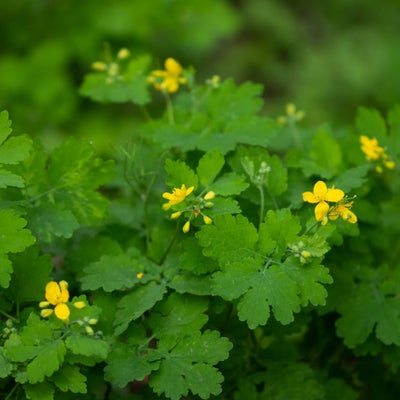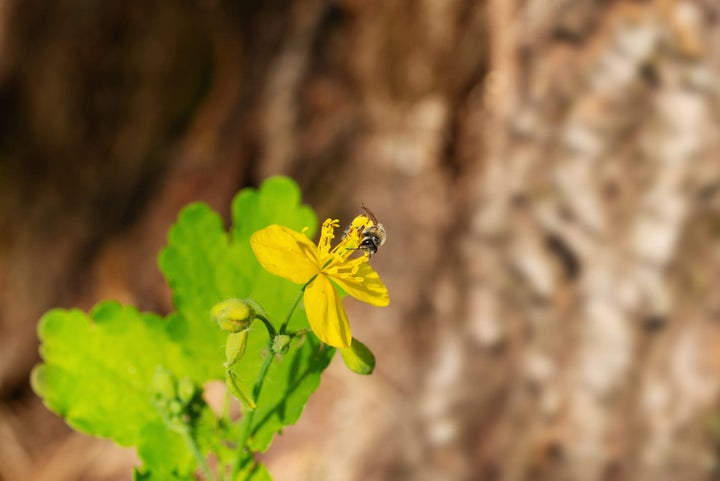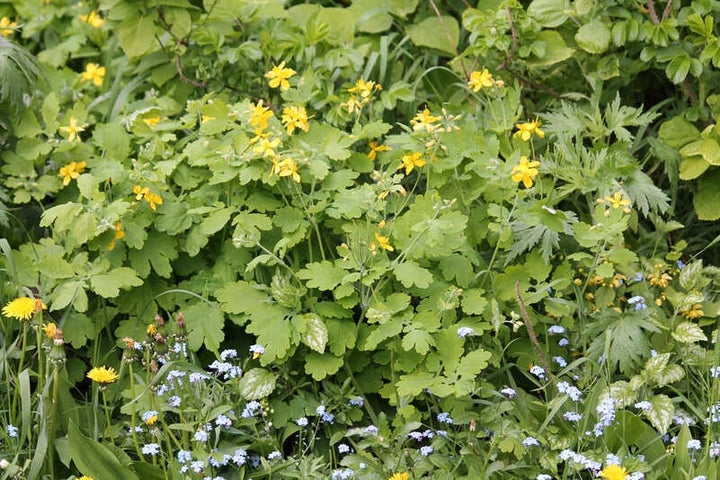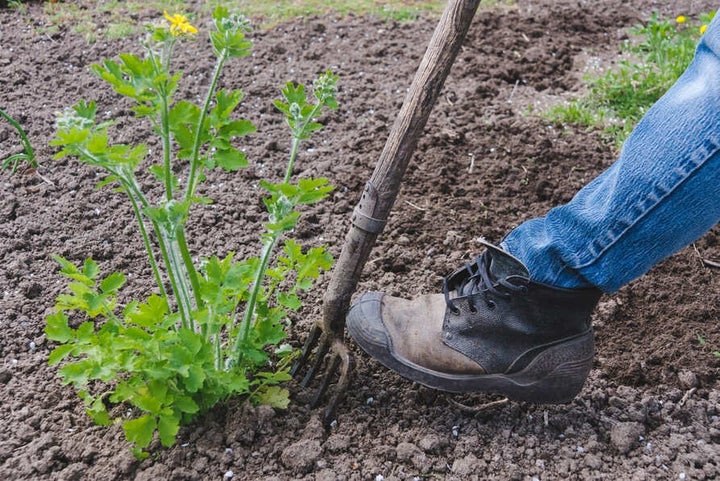
Quick facts
Greater celandine’s botanical name is Chelidonium majus; it is also known as swallow wort and the celandine poppy
It is a naturalised plant, introduced to the UK during medieval times
In gardens, it is most commonly found in moist, semi-shaded borders
Its flowers and dense leafy growth support a variety of wildlife
Greater celandine isn't edible – all parts of this plant are harmful if eaten and its sap is a skin irritant
If you need to control greater celandine, non-chemical methods are very effective
What does greater celandine look like?
Greater celandine is a tall , growing to around 90cm (3ft) in moist, shady conditions; it may be considerably shorter in dry, sunny spots. It has an open, branching habit with slightly hairy, brittle stems that bear broadly lobed greyish-green leaves with rounded leaflets. Underground, greater celandine grows from a thick, woody and several long, orange-tinted roots. The stems, leaves and roots all exude orange when cut.
Small, bright yellow flowers with four petals are held in clusters at the stem tips. Individual flowers are short-lived, but many are produced from May to September. Flowers are followed by cylindrical seedpods 3-5cm (1¼-2in) long, each containing many shiny black seeds.

Despite having a similar common name, greater celandine is unrelated to lesser celandine (Ficaria verna). Greater celandine is in the poppy family, whereas lesser celandine, which flowers earlier in the year and is much smaller in stature, belongs to the buttercup family. Greater celandine may also be confused with St John's wort (Hypericum perforatum), as it too grows in shady places and has tall growth with yellow flowers.
Did you know?
Chelidonium is derived from the Greek word chelidon, meaning swallow, and it was traditionally believed that this plant starts flowering as the first swallows arrive in spring.
Is greater celandine a weed?
Greater celandine is a wildflower, commonly found on roadside verges, at the base of hedgerows, on waste ground and in open woodland. It is an archaeophyte (introduced by humans before 1500 and now ) and supports a variety of our wildlife, including bees and flies that pollinate its flowers, ground-active invertebrates that find shelter in its tall, dense foliage and ants that feed on and disperse its seed.
As greater celandine flowers over a long period, from late spring to early autumn, it makes a valuable addition to a wildlife garden or damp meadow. Its sunny yellow flowers also provide attractive ground cover under trees and in lightly shaded, woodland-edge borders.


However, the tall stems of greater celandine can shade and outcompete smaller plants, so you may wish to remove it from parts of your garden where you grow small or young plants.
What is a weed?
The term ‘weed’ describes a plant that is growing where it isn’t wanted. Weeds usually thrive in average garden conditions, reproducing and spreading easily. It is up to you to decide what you call a weed and what you choose to retain or remove.
Frequently asked questions about controlling greater celandine
Here are our answers to your most common questions about dealing with greater celandine:
How invasive is greater celandine?
Greater celandine spreads by seed, and a single plant can produce hundreds of seed throughout the growing season. As the seed is dispersed by ants (see below), can appear some distance from the parent plant.
Did you know?
Ants are attracted to a fleshy, fat-rich appendage on the outside of the seed coat called an elaiosome. Ants carry ripe seed into their nests and feed the elaiosome to their larvae before depositing the seed in the rich soil of their waste piles, where it germinates.
Greater celandine is persistent, growing from a thick , and is able to regrow if the taproot is damaged. This means it can be tricky to completely eradicate plants once they become established. The good news is that it is easy to prevent plants spreading and becoming established, by deadheading and removing unwanted seedlings, so it is still possible to enjoy greater celandine in your garden without it becoming a nuisance.
Do I need to get rid of greater celandine?
No – allowing greater celandine to grow in a damp meadow, woodland border, wildlife corner or less-cultivated area is a great way to attract wildlife and boost the of your garden. It also gives you the chance to enjoy its attractive flowers.
It is, however, a good idea to control the spread of greater celandine to stop it becoming established or too abundant in parts of the garden where it might smother and outcompete other plants. As greater celandine is poisonous and its is a skin irritant, you may want to remove it if there is a chance children or pets could touch or eat some.
What is the easiest way to kill greater celandine?
If you have greater celandine growing where it is not wanted, there are a few ways to remove it:
- – regularly snip off spent flowers to prevent plants setting seed. Be sure to wear gloves and cover skin to avoid contact with the sap.
- Hoe off seedlings – greater celandine seedlings quickly develop a long, thick taproot, so keep an eye out for any appearing around the garden in spring. Hoe on a warm, dry, or windy day, so exposed roots dry out quickly.
- Fork out plants – remove before they begin flowering and setting seed. Greater celandine grows from a thick taproot that can be difficult to pull from the soil, so use a hand or border fork to lever it out instead. Insert this to its full depth, close to the base of the plant, to minimise soil disturbance.
- Smother seedlings – apply a of organic matter, around 10cm (4in) thick, to your soil in early spring to reduce and smother emerging seedlings. Alternatively, fill gaps in borders with ground cover plants.
- Cover the soil – a good option if you have a large area of greater celandine you wish to remove. Strim off any top growth and cover the soil with a layer of compostable material, such as cardboard, and then a layer about 20cm (8in) thick of organic matter, such as or wood chips. Alternatively, use a heavy grade mulch matting. This will block light and prevent growth, causing the root system to die. Keep soil covered for a few years, topping up the mulch layer if necessary, to ensure this method is effective.

Top Tip
Don’t add greater celandine roots or seed to your home compost bin, as it may not reach high enough temperatures to kill them. Instead, put them in your council green waste recycling bin or take them to your local recycling site.
Should I use weedkiller?
No – as greater celandine can be removed using non-chemical methods, there is no need to use a weedkiller.
For more information, see our page on Weeds: non-chemical controls.












